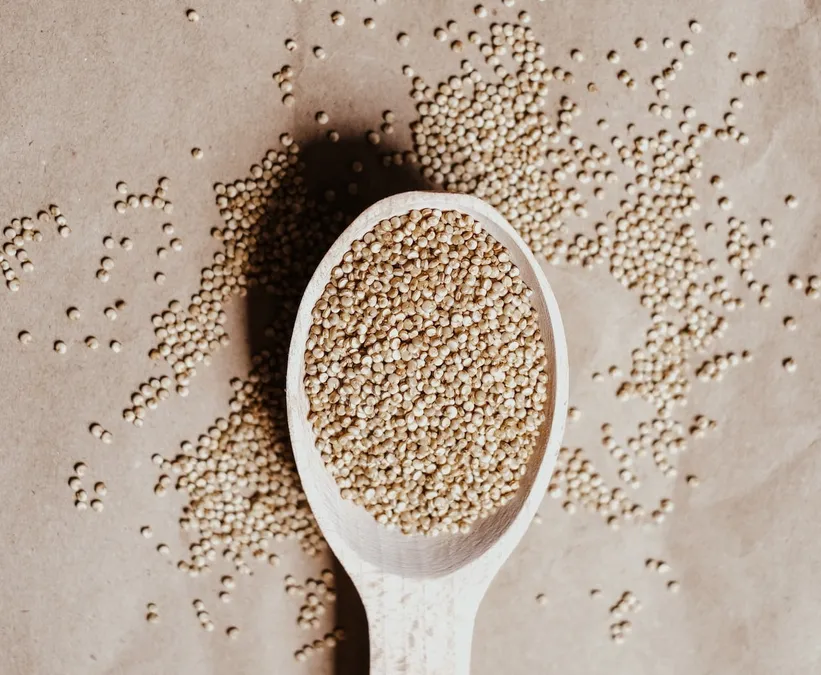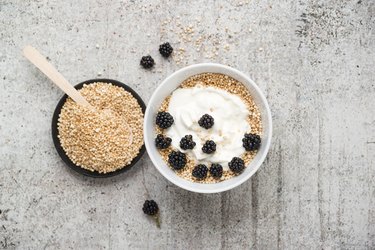When it comes to our diet, making informed choices is essential for our health and well-being. In the battle of the grains, oats and quinoa often take center stage as nutritional powerhouses. But which one truly packs a stronger punch in terms of health benefits?
Today, we delve into the Grain Showdown: Oats vs Quinoa, exploring their nutritional profiles to help you make the best decision for your diet. Let’s uncover the facts behind these popular grains and find out which one reigns supreme in the realm of health and nutrition.
Nutritional Powerhouses: Oats and Quinoa
Oats and quinoa are both nutritional superstars. They offer a variety of valuable nutrients that can significantly contribute to a healthy diet.
Oats: A Fiber Champion
Oats are particularly well-known for their high fiber content. A single 100-gram serving packs a whopping 10 grams of fiber! This keeps your digestive system running smoothly, helps you feel fuller for longer, and can even aid in weight management. Oats are also a source of essential vitamins and minerals, including manganese, phosphorus, and magnesium, all of which play important roles in keeping your body functioning optimally. With their low-fat and cholesterol-free profile, oats are a perfect choice for anyone looking to maintain a healthy weight or manage cholesterol levels. Adding oats to your diet is a simple way to boost the nutritional value of your meals.
Quinoa: The Complete Protein Powerhouse
Quinoa has earned its reputation as a superfood thanks to its impressive nutrient profile. Unlike many other plant-based proteins, quinoa is a complete protein, containing all nine essential amino acids that our bodies cannot produce on their own. A 100-gram serving of cooked quinoa provides around 4 grams of protein, making it a valuable option for vegetarians and vegans. Quinoa is also a good source of dietary fiber, just like oats, with about 2.8 grams per 100 grams. Additionally, quinoa is rich in essential minerals like iron, magnesium, and phosphorus, which are crucial for many bodily functions. With its high protein and fiber content, quinoa is a perfect choice for anyone looking to improve their overall health and well-being.
Health Benefits Of Oats And Quinoa

Both oats and quinoa are powerhouses of nutrition. Oats are celebrated for their high fiber content, which keeps you feeling full and aids in digestion. This makes them a great choice for weight management. They also contain beta-glucan, a soluble fiber that can lower cholesterol and reduce the risk of heart disease.
Quinoa, on the other hand, shines with its complete protein profile, making it a valuable option for vegetarians and vegans. It’s also rich in antioxidants and minerals like iron and magnesium, contributing to overall health.
Incorporating both oats and quinoa into your diet is a smart way to reap a variety of health benefits.
1. Health Benefits of Oats
Eating oats offers a wealth of health benefits. First and foremost, they’re packed with fiber, which aids in digestion and helps maintain a healthy weight. Additionally, the beta-glucan in oats can lower cholesterol and reduce the risk of heart disease. Oats are also a good source of antioxidants that protect against cell damage and inflammation. They provide sustained energy and can help regulate blood sugar levels, making them particularly beneficial for people with diabetes. Including oats in your diet is a great way to promote overall health and well-being.
2. Health Benefits of Quinoa
Quinoa is another nutritious grain that offers numerous benefits when incorporated into a balanced diet. Firstly, it’s a complete protein source, containing all the essential amino acids that our bodies cannot produce on their own. This makes it an excellent choice for vegetarians and vegans. Secondly, quinoa is rich in fiber, promoting healthy digestion and preventing constipation. It’s also packed with antioxidants that can help protect against chronic diseases like heart disease and certain types of cancer. Additionally, quinoa is naturally gluten-free, making it suitable for people with gluten sensitivities or celiac disease. Including quinoa in your meals can significantly contribute to your overall health and well-being.
Oats and Quinoa: Versatile Grains for Every Meal

Highly Adaptable Ingredients
Both oats and quinoa are incredibly versatile grains that can be cooked in various ways and incorporated into a wide range of dishes.
- Oats: Often prepared by boiling them in water or milk, oats create a creamy and satisfying porridge. They’re perfect for a hearty breakfast, baked goods like muffins and cookies, or even savory meals like oatmeal bowls and veggie burgers.
- Quinoa: Cooked by simmering in water or broth, quinoa boasts a nutty flavor and a slightly crunchy texture. It can be a fantastic substitute for rice or couscous in salads, pilafs, stir-fries, or even vegetable stuffing. Quinoa flour can also be used in baking.
Cooking Methods for Oats
Cooking oats is a breeze, allowing you to customize the texture and flavors to your preference.
- Boiling: The most common method involves boiling oats in water or milk for a creamy porridge. Enhance the flavor with sweeteners like honey or maple syrup, and top it off with fruits, nuts, or cinnamon.
- Overnight Oats: For a quick grab-and-go breakfast, try overnight oats. Combine oats with your chosen liquid (almond milk or yogurt works well) and let it soak in the fridge overnight. This creates a soft and chewy texture.
- Baking: Don’t forget baking! Oats add a wholesome and nutty flavor to cookies, muffins, and granola bars.
Cooking Methods for Quinoa
There are two popular methods to cook quinoa and bring out its best qualities:
- Absorption Method: Similar to cooking rice, this method involves simmering quinoa in a specific water or broth ratio until all the liquid is absorbed. This ensures perfectly cooked and fluffy quinoa grains.
- Pilaf Method: Toasting quinoa in oil or butter before adding liquid enhances its flavor with a nutty note. After simmering until cooked, the result is a light and fluffy texture. Both methods are versatile and can be easily adapted to include additional herbs and spices for even more flavor.
Sustainability And Environmental Impact

Good news! Both oats and quinoa are excellent choices for a sustainable diet. Let’s explore why:
Oats: A Cool and Resource-Friendly Crop
- Less water means more harvest: Oats thrive in cooler climates, needing less water and resources than other grains. This makes them a water-wise option.
- Happy soil, happy oats: Oats are commonly used in crop rotation. This practice improves soil health and reduces the need for pesticides, benefiting both the environment and farmers.
- Speedy and sustainable: Oats boast a shorter growing season compared to other grains, leading to a lower carbon footprint.
Quinoa: A Tough and Eco-Conscious Grain
- Drought-resistant champion: This hardy crop flourishes in harsh environments and tolerates drought conditions, making it ideal for regions with limited water resources.
- Natural pest control: Quinoa plants are like tiny bodyguards, repelling pests naturally, minimizing the need for harmful chemicals.
- Organic champion: Quinoa is often cultivated using traditional and organic methods. This promotes biodiversity and protects the soil, promoting a healthy planet.
Both oats and quinoa are sustainable choices. Oats require less water and resources, while quinoa thrives in challenging environments and is often grown organically. Whichever you choose, you’re contributing to a more sustainable food system!
Taste And Texture Comparison
Oats and quinoa offer distinct taste and texture experiences. Cooked oats have a nutty, slightly sweet flavor and a creamy, soft texture. They’re often described as comforting and hearty, making them perfect for warm breakfast bowls or baked goods.
On the other hand, quinoa boasts a mild, slightly earthy taste with a light and fluffy texture. Its delicate grains add a subtle crunch to dishes. Whether you prefer the comforting creaminess of oats or the light fluffiness of quinoa, both grains offer unique profiles that enhance your meals.
Oats: A Nutty and Comforting Taste
Oats have a distinctive taste that many find appealing. Their nutty and slightly sweet flavor adds depth and richness to dishes. This versatility makes oats a great ingredient for both sweet and savory recipes.
When cooked, oats develop a creamy and soft texture that further complements their taste. Whether enjoyed in a warm bowl of oatmeal, homemade granola bars, or even baked goods like cookies and bread, oats provide a hearty and satisfying taste you can enjoy anytime.
Quinoa: A Unique and Versatile Grain
Quinoa’s taste profile sets it apart from other grains. It has a subtle nuttiness with a hint of sweetness, offering a delicate and slightly earthy flavor that’s mild and pleasant. Cooked quinoa boasts a fluffy and slightly chewy texture, adding a delightful mouthfeel to dishes.
Quinoa’s versatility allows it to absorb the flavors of other ingredients, making it a great base for various recipes. Whether used in salads, stir-fries, or as a side dish, quinoa’s distinct taste adds a satisfying element to any meal.
Conclusion
Both oats and quinoa are powerhouses of nutrition, making them excellent choices for a balanced diet.
- Oats are high in fiber, promoting fullness and aiding digestion. They also provide essential minerals like iron, magnesium, and zinc.
- Quinoa: A complete protein source containing all nine essential amino acids. Quinoa is also rich in magnesium, potassium, and antioxidants.
Choosing Between Them:
Ultimately, the choice depends on your needs and preferences.
- For increased fiber and healthy digestion, Choose oats.
- For a complete protein source, Choose quinoa.
Both grains are versatile! They can be incorporated into various dishes to suit your taste. Consider your dietary goals and consult a healthcare professional for personalized advice.
FAQ About Grain Showdown: Oats Vs Quinoa: Which Packs A Nutritional Punch?
Q: What are the nutritional benefits of oats?
A: Oats are packed with fiber, protein, antioxidants, and important vitamins and minerals like manganese, phosphorus, magnesium, and iron.
Q: How does quinoa compare to oats in terms of nutrition?
A: Quinoa is a complete protein, rich in fiber, and loaded with essential nutrients such as iron, magnesium, and zinc, making it a great alternative to oats.
Q: Which grain is better for weight management, oats or quinoa?
A: Both oats and quinoa can be beneficial for weight management due to their high fiber content, which aids in promoting satiety and regulating blood sugar levels.
Q: Are oats and quinoa suitable for gluten-free diets?
A: Yes, both oats and quinoa are naturally gluten-free, making them excellent options for individuals following a gluten-free diet.
Q: How can oats and quinoa be incorporated into daily meals?
A: Oats can be enjoyed as oatmeal, granola, or added to baked goods, while quinoa can be used in salads, soups, stews, or as a side dish, providing versatility in meal planning.
Q: Which grain is more budget-friendly, oats or quinoa?
A: Oats are typically more budget-friendly compared to quinoa, offering a cost-effective option for those looking to add a nutritious grain to their diet.

The Finer Diner has a rich history deeply rooted in the Mt. Oliver and Hilltop community. Our journey began with a simple yet ambitious vision – to create a welcoming space where friends and families could come together to enjoy delicious, comforting meals in a classic diner-style setting. Since our establishment, we have been dedicated to serving food, creating lasting memories, and fostering a sense of belonging within our community. Our commitment to quality, authenticity, and exceptional service has been the cornerstone of our success.